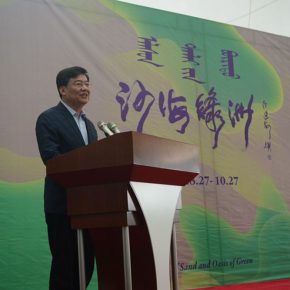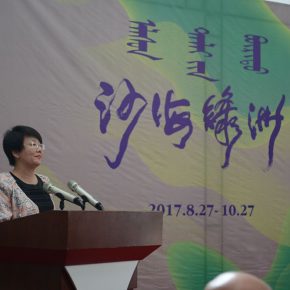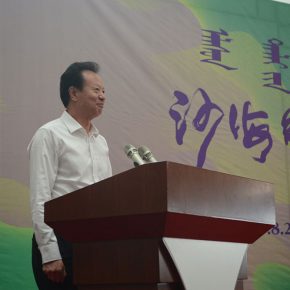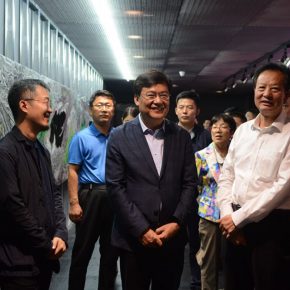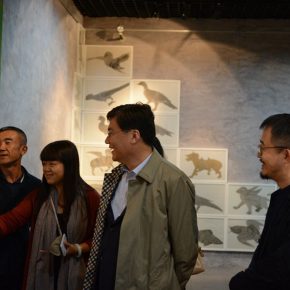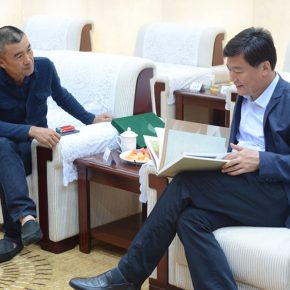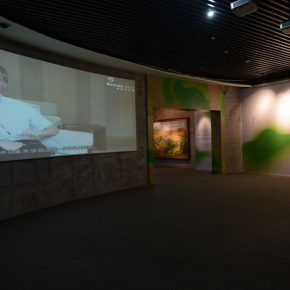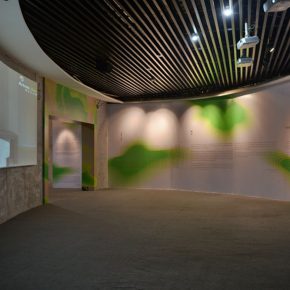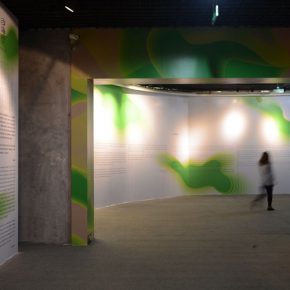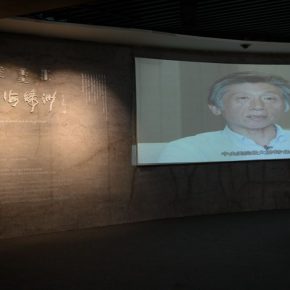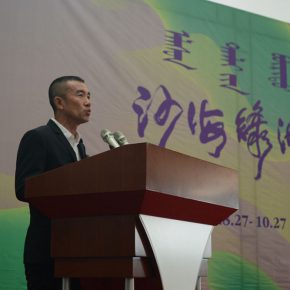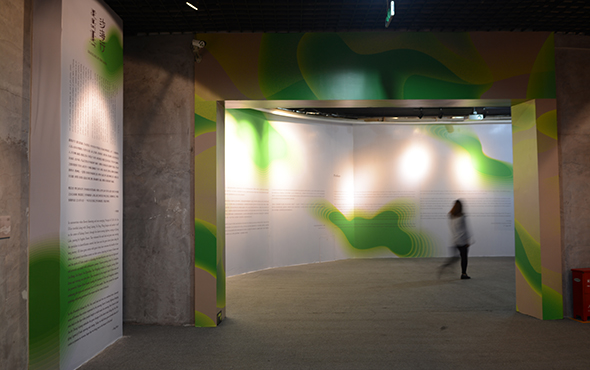
In order to coordinate the 13th U.N. Convention to Combat Desertification (UNCCD) conference which is held by the Secretariat of U.N. Convention to Combat Desertification (UNCCD) and supported by the Government of the People's Republic of China, opening in Ordos in the Inner Mongolia Autonomous Region, in order to improve the cultural communication between China and foreign countries, the exhibition “Sea of Sand and Oasis of Green”, hosted by the Central Academy of Fine Arts (CAFA) and the People's Government of Ordos, collaborated by the School of the Plastic Arts of the Central Academy of Fine Arts, Publicity Department of CPC Ordos Municipal Committee, Ordos Federation of Literary and Art Circles, Administration of Press, Publication, Radio, Film and Television of Ordos opened at the Ordos Museum on August 27, 2017. This exhibition gathers 45 works with a variety of forms, such as painting, sculpture, installation and video, by 49 artists, including faculty staff in CAFA and other Chinese artists; including Chinese paintings and oil paintings that depict characteristic scenery of Ordos. It aims to show the high quality of contemporary Chinese art, as well the unique cultural image of Ordos.
Cao Zhichen, Vice Mayor of Ordos City presided over the opening ceremony. Wang Jianguo, Chairman of CPPCC of Ordos announced the opening, Su Cuifang, a member of the Standing Committee of Ordos and Minster of Publicity Department of Ordos, Gao Hong, Secretary of the Party Committee of CAFA, and Zhang Lujiang, Deputy Dean of the School of Plastic Arts, Central Academy of Fine Arts, and Director of the Department of Fundamental Education for Plastic Arts, respectively delivered a speech at the opening ceremony.
Gao Hong, Secretary of the Party Committee of CAFA, wrote in the preface that, from the perspective of regional culture, Ordos has successfully created unique cultural characteristics during its long history of development. Today’s Ordos has achieved a great contribution to desertification control and environmental conservation under the context of globalization, earning its international attention and reputation. Upon this broad and flourished land, thousand of years of cultural and multi-ethnical memories have been accumulated into the Mongolian culture, becoming an indispensable part of Chinese civilization. This exhibition wishes to face more ethnic groups and minority nationalities, as well as foreign audiences, aiming to provoke more possibilities and vitality in viewing and communicating; it also provides a great opportunity for CAFA to present and communicate with international institutions.
The exhibition theme is Sea of Sand and Oasis of Green, which is shaped by the thoughts in the face of multiple realities, and the exhibited works are not merely aesthetic objects, but also a path of thoughts to explore broader fields such as nature, cultural environment, ethnic civilization and contemporary introspection. The background of the exhibition and the breadth of its thinking also offer an opportunity to jointly explore the issue of regional development and cultural revitalization, so that, it launched a forum on this theme, invited a number of well-known art theorists and cultural scholars, including Prof. Zhao Li and Prof. Cao Qinghui from CAFA, Sun Feng, Project Director of China Arts and Entertainment Group, Peng Wei, Executive Director of Art Nova 100, Du Lin, with a master’s degree from Harvard University and a doctoral degree from University of California, Los Angeles, Sheng Wei, Editor-in-Chief of the “Fine Arts” journal, Wei Xiangqi, a Ph. D of Fine Arts and working in the National Art Museum of China, Zhang Han, a teacher of the Department of Fundamental Education for Plastic Arts, CAFA, and Bai Yan, General Manager of Ordos Art and Future Culture Creative Industry Management Co., Ltd. participated in the forum. Wu Yongguang, Vice Chairman of Ordos Federation of Literary and Art Circles and curator Liu Libin presided over the forum.
On the basis of the targeted issues of the exhibition, the honored guests of the forum had a discussion on how art more effectively and actively participated in the regional development and cultural revitalization. First of all, Vice Chairman Wu Yongguang introduced the cultural traditions and present developmental situation, and he believed that this exhibition and forum provided a good opportunity for the cultural development of Ordos. Prof. Zhao Li highlighted the change in regional energy development to the cultural development, discovering the local cultural tradition and seeking cultural contemporary innovation. Prof. Cao Qinghui said that, only by paying attention to the diversity of contradictions, focusing on the excavation of indigenous methods, can the cultural revitalization have a long-term development. Sheng Wei stressed that the balance of cultural and artistic resources is in need of the development of the culture and art of the community, and he proposed two proposals on the community development and industrialization of art and culture. Sun Feng said that it was both based on the local and integration of more comprehensive cultural resources and an international vision in terms of regional development and cultural revitalization. Peng Wei made a suggestion on how to make contemporary culture become involved in local culture and traditional culture, and proposed that it is necessary to continuously integrate, reflect and to borrow thoughts. Dr. Du Lin took “Establishment of the Collection of Regional Art Museum and International Vision” as the theme, taking the example of the Museum of Modern Art in New York, United States, (MOMA) as an example, to explore how to play a geographical advantage to establish an art museum, proposing that they can only depend on the geographical advantages to establish a core collection with a clear context, it gave the art museum a long-term cultural value. Dr. Wei Xiangqi made a suggestion on openness and interaction which was needed in the process of regional cultural development, emphasizing that the temporary interaction should become more long-term and stable, and have a collation of relevant literature, to improve the effectiveness of the cultural interaction.
Bai Yan finally delivered a speech and said that the nomadic culture of Ordos and modern network culture has a similar liquidity, emphasizing the cultural resources as nourishment for the spirit of people. All honored guests gave speeches and exchanges on different specific issues, which further enhanced the practical significance and the significance of research of this exhibition.
The exhibition theme is “Sea of Sand and Oasis of Green,” with four parts including “Traveling in the Sand”, “In Between the Landscape”, “Facing the Landscape”, and “Image of Life”, which do not only encourage this large group exhibition to be grasped by the audience with perceptible visual rhythms but also establishes many perceptive ways of going deep into the artistic language, bringing the audience a fresher artistic experience and deep and broad cultural vision integrating China and the West.
The leaders and minority audiences from the minority areas who are about to participate in the 13th U.N. Convention to Combat Desertification (UNCCD) conference will visit the show during the period of the holding of the exhibition. It opens a new window between the inner and outside world of art, mounting an extraordinary cultural landscape to Ordos and the 13th UNCCD conference. The exhibition has multiple cultural significances and practical significances, and also gives new impetus and direction for the revitalization of regional culture and the development of culture and environment.
Text by Wei Xiankun , translated by Chen Peihua and edited by Sue/CAFA ART INFO
Photo by the organizer
About the Exhibition
Title: Sea of Sand and Oasis of Green
Duration: August 27 – October 27, 2017
Venue: Ordos Museum, Inner Mongolia Autonomous Region
Hosts: Central Academy of Fine Arts (CAFA), People’s Government of Ordos
Collaborators: School of the Plastic Arts of the Central Academy of Fine Arts, Publicity Department of CPC Ordos Municipal Committee, Ordos Federation of Literary and Art Circles, Administration of Press, Publication, Radio, Film and Television of Ordos.
Chief Planning: Gao Hong, Gong Mingzhu
Academic Director: Fan Di’an
Art Director: Su Cuifang, Zhang Lujiang, Feng Shiye, Zeng Han
Curator: Liu Libin
Assistant Curators: Fu Rui, Wei Xiankun, Wang Yidan, Jiao Yunjiao, Huang Hui
Exhibition Design: Dongchen Design (Wang Donglin, Chen Yijun, Zhang Yawen)
Prefaces of the Parts of the Exhibition
Traveling in the Sand:In early August, when the sun shines overwhelmingly upon the sandy land, Director of CAFA, Mr. Fan Di’an travelled along with Zhang Lujiang, Yu Ding, Wang Jianguo and another 4 staff to the centre of the Kubuqi Desert, through the desert-crossing highway, staying in Qixing Lake, passing by the Engebei Desert. They witnessed the regions of sand and green oasis, meeting the specialists in desertification control; they have seen the green desert plants along the long journey. All these great artists with great virtues have overcome the hostility of sunshine, and painted marvelous scenery on their canvas, depicting the beauty of the desert oasis and the spirits of Ordos people in defending the desertification; more than ten high-standard artworks are made with enthusiastic passion. Chinese painting artists Yu Guanghua, Liu Jingui, Yao Mingjing, Yue Qianshan, Liu Rong, travelled to Xiangsha, crossing Yellow River and viewing rare pine trees. They wandered in this magical land of the Ordos oasis and the powerful Yellow River banks, sensing the harmony of Han and Mongolian residents, embracing the open and optimistic heart of the Ordos people. Thus they present five exquisite paintings, depicting the greatness of nature and the virtues of ethnicity.
–Feng Shiye
In Between the Landscape:
The virtuous finds pleasure in mountains, the wise find pleasure in water. Along with history, mountains and waters are classical imagery of Chinese culture, gaining broader connotation through one’s mind and heart, through the ink art, through classics and the court. Landscapes embrace men, varying in form and presentations because of men, while men develop themselves in the landscape. The bond between the landscape and humans is never reduced, even after the triumph and turmoil in modern times. This is the reason why we see the great nature in ink landscapes, and why we inherit the tradition after wandering through the scenery. Our minds transit, while the landscape stays the same; only by exploring the truth of nature can we extend the life of our tradition. The form and material of art are numerous in original creativity; the blossoms of art flourishes, and the glory of the moon shines through clouds.
–Liu Libin
Facing the Landscape:
Here opens the great landscape. In Between the Landscape opens my heart and mind; facing the Landscape reaches my spirit through gazing. In the far beyond there is floating clouds, while in the near foreground there is renewable scenery. Confronting the supernatural power of landscape, I face and communicate with it. Is the landscape in Western and Eastern divisions? ‑The answer varies. It is the moment of where you are standing; it is neither the past nor the future. Focus on the moment, sketching the ground that surrounds me, and transforming the landscape with brushstrokes - one is reasoning the physical world, embracing nature, transporting the external and internal, and then one lives its momentous life.
–Liu Libin
Image of Life:
Spirits live in the form, with one phase of dynamic and one of static. The dynamic, rotating day and night, belongs not only to things that move, but to the ever-changing living inheritance, to the flowing liveliness and various forms brought by wind and days. A particle of extraordinary velocity exceeds its physical existence and reaches the unlimited cosmos. The existence of the dynamic is minimum, while the nihility extends to the void. The static, seemingly no inhaling or exhaling, belongs not to the nature of unmoving objects, but to the vigilance and strength of a resting leopard, to vicissitudes of the earth, to transformation of auspicious clouds. In the eyes of the elder monk who is enlightened in the ancient temple, one leaf symbolizes the bodhi tree, and one flower embraces the entire world. The existence is the form, which is utilized through the nihility. Comprehending the reason of the dynamic and static, one can minimalize the brushstroke within the painting, to manipulate movements in limited material sizes, and to create the flying lines and patterns as running swift horse on greater land. Spirits flow in the binary of existence and nihility.
–Liu Libin
List of Participating Artists (49 artists)
Traveling in the Sand: Fan Di’an, Zhang Lujiang, Yu Guanghua, Liu Jingui, Yao Mingjing, Yu Ding, Wang Jianguo, Yue Qianshan, Liu Rong
In Between the Landscape: Chen Ping, Chen Qi, Qiu Zhijie, Zhan Wang, Qiu Ting, Wu Yongguang, Yao Lu, Huang Yang, Li Hongbo, Yang Xinguang, Wang Shang
Facing the Landscape: Wang Shaojun, Ma Lu, Wang Chuan, Bai Xiaogang, Liu Shangying, Li Ronglin, Lu Bin, Dang Wenliang, Kang Lei, Tang Chenghua, Li Bingjun, Lu Zhengyuan, Su Haijian
Image of Life: Su Xinping, Lv Pinchang, Lv Shengzhong, Wang Huaxiang, Tang Hui, Wang Zhong, Li Yang, Xiao Li, Yu Fan, Yao Shunxi, Shen Hongbiao, Wu Hong, Wu Jian’an, Xie Qing, Hu Hefu, Liu Wentao


